Incorporating Concentrating Solar Power into High Renewables Penetrated Power System: A Chance-Constrained Stochastic Unit Commitment Analysis
Abstract
:1. Introduction
- (1)
- A two stage stochastic UC model is established to research on the economic and reliable values of a CSP with TES/EH in the high renewables penetrated power system, concerning the uncertainty of wind power, PV and the solar energy received by CSP.
- (2)
- A chance-constrained method is employed in UC model to optimize the system reserves according to the scenario-based renewable energy forecast data.
- (3)
- The dispatchability and profitability of a CSP with TES/EH in unit commitment are verified through the comparative experiments among various system configurations.
2. Model of Concentrating Solar Power (CSP) Station Equipped with Thermal Energy Storage (TES) and Electrical Heater (EH)
3. Chance-Constraint Two-Stage Stochastic Unit Commitment
3.1. Uncertainty of Renewables
3.2. Scenario-Based Day-Ahead Unit Commitment
3.2.1. Objective
3.2.2. The First-Stage Constraint
3.2.3. The Second-Stage Constraint
3.3. Chance-Constrainted Reserve Planning Model
4. Results
4.1. Test System
4.2. Results of the Proposed Model
4.2.1. Probabilistic Renewable Energy Scenarios and the Load Power Forecast
4.2.2. The Dispatch Results of the Multiple Resources with CSP and EH
4.2.3. The Unit Commitment Results Considering CSP and EH
5. Discussion
5.1. The Effects of CSP and EH in Energy Services
5.1.1. The Influences of CSP and EH on Unit Commitment
5.1.2. The Influences of CSP and EH on Renewables Curtailment
5.2. The Effects of CSP and EH in Reserve Services
5.2.1. Comparison Among Different Reserve Planning Decisions
5.2.2. Chance-Constrained Reserve Scheduling
6. Conclusions
- (1)
- In the large-capacity renewables penetration system, the utilization of a TES and an EH could reduce the generation costs of thermal units and penalty costs for renewables spillage. The higher ramp rate and range of the CSP than thermal units support it to provide large scale of firm capacity. The reduced requirement of thermal units allows for greater renewables penetration. The EH enables the CSP to convert excess renewables generation into thermal units stored in TES for later use, which further utilizes the room of the TES system and reduces the renewables spillage significantly. The dispatchable CSP station with TES and EH makes a 100% renewable-dominated power system possible.
- (2)
- The reserve services provided by the CSP system with TES and EH could help decline the reserve costs. The capacity of CSP reserves mainly provides the reserve scheduling services through replacing expansive thermal unit reserves. The incorporation of an EH alleviates the renewables uncertainty to avoid unpredicted thermal unit reserve deployment.
- (3)
- In particular, the TES produces additional value by realizing the solar power shift to the periods of reduced power output and between different days. The complementary effects of solar-driven power CSP and PV stations enable greater use of solar energy especially in the high solar power penetrated power system.
- (4)
- Compared with a conventional reserve planning model, the proposed chance-constrained reserve scheduling has both economic value and reliable significance. The severe consequences of load shedding are greatly hedged in the proposed reserve planning method.
Author Contributions
Funding
Conflicts of Interest
Abbreviations
| Abbreviation | Full Name | Abbreviation | Full Name |
| CSP | concentrating solar power | DNI | direct normal irradiation |
| ED | economic dispatch | EENS | expected energy not supplied |
| EH | electrical heater | ELNS | expected load not served |
| EWVS | expected wind and solar curtailment | FLH | full-load hour |
| HTF | heat transfer fluid | IEEE | Institute of electrical and electronics engineers |
| LSH | Latin hypercube sampling | LOLP | loss-of-load probability |
| NP-Hard | non-deterministic polynomial hard | PB | power block |
| probability distribution function | PV | solar photovoltaic | |
| RTS | reliability test system | SF | solar field |
| SM | solar multiple | SOC | state of charge |
| TES | thermal energy storage | UC | unit commitment |
Appendix A
Appendix B
| Number | Test Time/h | Scheduling Cost of Up Reserve/MW | Scheduling Cost of Down Reserve/MW | Deploying Cost of Up Reserve/MW | Deploying Cost of Down Reserve/MW |
|---|---|---|---|---|---|
| 1 | 76 | 17 | 120 | 27.27 | 0.00222 |
| 2 | 76 | 17 | 120 | 27.27 | 0.00222 |
| 3 | 76 | 17 | 120 | 27.27 | 0.00222 |
| 4 | 76 | 17 | 120 | 27.27 | 0.00222 |
| 5 | 76 | 17 | 120 | 27.27 | 0.00222 |
| 6 | 76 | 17 | 120 | 27.27 | 0.00222 |
| 7 | 76 | 17 | 120 | 27.27 | 0.00222 |
| 8 | 76 | 17 | 120 | 27.27 | 0.00222 |
| 9 | 350 | 29 | 200 | 17.92 | 0.00031 |
| 10 | 197 | 23 | 160 | 16.6 | 0.002 |
| 11 | 197 | 23 | 160 | 16.6 | 0.002 |
| 12 | 155 | 21 | 150 | 19.7 | 0.00398 |
| 13 | 155 | 21 | 150 | 19.7 | 0.00398 |
| 14 | 400 | 31 | 220 | 16.19 | 0.00048 |
| 15 | 350 | 29 | 200 | 17.92 | 0.00031 |
| Number | Capacity/MW | Coal Consumption Coefficient | Initial State/h | Minimum on Time/h | Minimum off Time/h | Warm Start Cost/MW | Cold Start Cost/MW | Maximum Hot Start Time/h | |||
|---|---|---|---|---|---|---|---|---|---|---|---|
| a/MJ | b1/(MJ) | b2/(MJ/MW·h) | b3/(MJ/MW2·h) | ||||||||
| 1 | 76 | 17 | 120 | 27.27 | 0.00222 | −1 | 1 | 1 | 2300 | 4600 | 0 |
| 2 | 76 | 17 | 120 | 27.27 | 0.00222 | −1 | 1 | 1 | 2300 | 4600 | 0 |
| 3 | 76 | 17 | 120 | 27.27 | 0.00222 | −1 | 1 | 1 | 2300 | 4600 | 0 |
| 4 | 76 | 17 | 120 | 27.27 | 0.00222 | −1 | 1 | 1 | 2300 | 4600 | 0 |
| 5 | 76 | 17 | 120 | 27.27 | 0.00222 | −1 | 1 | 1 | 2300 | 4600 | 0 |
| 6 | 76 | 17 | 120 | 27.27 | 0.00222 | −1 | 1 | 1 | 2300 | 4600 | 0 |
| 7 | 76 | 17 | 120 | 27.27 | 0.00222 | −1 | 1 | 1 | 2300 | 4600 | 0 |
| 8 | 76 | 17 | 120 | 27.27 | 0.00222 | −1 | 1 | 1 | 2300 | 4600 | 0 |
| 9 | 350 | 29 | 200 | 17.92 | 0.00031 | 6 | 6 | 6 | 10,000 | 20,000 | 4 |
| 10 | 197 | 23 | 160 | 16.6 | 0.002 | −3 | 4 | 4 | 5500 | 11,000 | 2 |
| 11 | 197 | 23 | 160 | 16.6 | 0.002 | −3 | 4 | 4 | 5500 | 11,000 | 2 |
| 12 | 155 | 21 | 150 | 19.7 | 0.00398 | −3 | 3 | 3 | 5000 | 10,000 | 1 |
| 13 | 155 | 21 | 150 | 19.7 | 0.00398 | −3 | 3 | 3 | 5000 | 10,000 | 1 |
| 14 | 400 | 31 | 220 | 16.19 | 0.00048 | 8 | 8 | 8 | 12,500 | 25,000 | 5 |
| 15 | 350 | 29 | 200 | 17.92 | 0.00031 | 6 | 6 | 6 | 10,000 | 20,000 | 4 |
References
- Du, E.S.; Zhang, N.; Hodge, B.M.; Wang, Q.; Kang, C.Q.; Kroposki, B.; Xia, Q. The Role of Concentrating Solar Power Toward High Renewable Energy Penetrated Power Systems. IEEE Trans. Power Syst. 2018, 33, 6630–6641. [Google Scholar] [CrossRef]
- Santosalamillos, F.J.; Pozovazquez, D.; Ruizarias, J.A. Combining wind farms with concentrating solar plants to provide stable renewable power. Renew. Energy 2015, 76, 539–550. [Google Scholar] [CrossRef]
- Chen, R.; Sun, H.B.; Guo, Q.L.; Li, Z.G.; Deng, T.H.; Wu, W.C.; Zhang, B.M. Reducing Generation Uncertainty by Integrating CSP With Wind Power: An Adaptive Robust Optimization-Based Analysis. IEEE Trans. Sustain. Energy 2019, 12, 583–594. [Google Scholar] [CrossRef]
- Kincaid, N.; Mungas, G.; Kramer, N. An optical performance comparison of three concentrating solar power collector designs in linear Fresnel, parabolic trough, and central receiver. Appl. Energy 2018, 231, 1109–1121. [Google Scholar] [CrossRef]
- Li, X.L.; Wang, Z.F.; Xu, E.S.; Ma, L.R. Dynamically Coupled Operation of Two-Tank Indirect TES and Steam Generation System. Energies 2019, 12, 1720. [Google Scholar] [CrossRef]
- Gafurov, T.; Prodanovic, M.; Usaola, J. Modelling of concentrating solar power plant for power system reliability studies. IET Renew. Power Gener. 2014, 9, 120–130. [Google Scholar] [CrossRef]
- Balghouthi, M.; Trabelsi, S.E.; Amara, M.B. Potential of concentrating solar power (CSP) technology in Tunisia and the possibility of interconnection with Europe. Renew. Sustain. Energy Rev. 2016, 56, 1227–1248. [Google Scholar] [CrossRef]
- Luo, Q.; Ariyur, K.B.; Mathur, A.K. Control-Oriented Concentrated Solar Power Plant Model. IEEE Trans. Control Syst. Technol. 2016, 24, 623–635. [Google Scholar] [CrossRef]
- Xu, T.; Zhang, N. Coordinated Operation of Concentrated Solar Power and Wind Resources for the Provision of Energy and Reserve Services. IEEE Trans. Power Syst. 2017, 32, 1260–1271. [Google Scholar] [CrossRef]
- Cocco, D.; Serra, F. Performance comparison of two-tank direct and thermocline thermal energy storage systems for 1 MWe class concentrating solar power plants. Energy 2015, 81, 526–536. [Google Scholar] [CrossRef]
- Manenti, F.; Ravaghiardebili, Z. Dynamic simulation of concentrating solar power plant and two-tanks direct thermal energy storage. Energy 2013, 55, 89–97. [Google Scholar] [CrossRef]
- Flueckiger, S.M.; Iverson, B.D.; Garimella, S.V.; Pacheco, J.E. System-level simulation of a solar power tower plant with thermocline thermal energy storage. Appl. Energy 2014, 113, 86–96. [Google Scholar] [CrossRef]
- Sioshansi, R.; Denholm, P. Benefits of Colocating Concentrating Solar Power and Wind. IEEE Trans. Sustain. Energy 2013, 4, 877–885. [Google Scholar] [CrossRef]
- He, G.; Chen, Q.; Kang, C.; Xia, Q. Optimal Offering Strategy for Concentrating Solar Power Plants in Joint Energy, Reserve and Regulation Markets. IEEE Trans. Sustain. Energy 2016, 7, 1245–1254. [Google Scholar] [CrossRef]
- Boland, J.; Cirocco, L.R.; Belusko, M.F.; Pudney, P. Controlling stored energy in a concentrating solar thermal power plant to maximise revenue. IET Renew. Power Gener. 2015, 9, 379–388. [Google Scholar]
- Kroposki, B.; Johnson, B.; Zhang, Y.C.; Gevorgian, V.; Denholm, P. Achieving a 100% Renewable Grid: Operating Electric Power Systems with Extremely High Levels of Variable Renewable Energy. IEEE Power Energy Mag. 2017, 15, 61–73. [Google Scholar] [CrossRef]
- Llamas, J.M.; Bullejos, D.; Ruiz de Adana, M. Optimal Operation Strategies into Deregulated Markets for 50 MWe Parabolic Trough Solar Thermal Power Plants with Thermal Storage. Energies 2019, 12, 935. [Google Scholar] [CrossRef]
- Chen, R.; Sun, H.; Li, Z.; Liu, Y. Grid Dispatch Model and Interconnection Benefit Analysis of Concentrating Solar Power Plants with Thermal Storage. Autom. Electr. Power Syst. 2014, 38, 1–7. [Google Scholar]
- Du, E.S.; Zhang, N.; Hodge, B.M.; Wang, Q.; Kang, C.Q.; Kroposki, B.; Xia, Q. Operation of a High Renewable Penetrated Power System With CSP Plants: A Look-Ahead Stochastic Unit Commitment Model. IEEE Trans. Power Syst. 2019, 34, 140–151. [Google Scholar] [CrossRef]
- Wagner, M.J.; Newman, A.M.; Hamilton, W.T.; Braun, R.J. Optimized dispatch in a first-principles concentrating solar power production model. Appl. Energy 2017, 203, 959–971. [Google Scholar] [CrossRef]
- Pozo, D.; Contreras, J. A chance-constrained unit commitment with an n-k security criterion and significant wind generation. IEEE Trans. Power Syst. 2013, 28, 2842–2851. [Google Scholar] [CrossRef]
- Luo, Y.; Lu, T.; Du, X.Z. Novel optimization design strategy for solar power tower plants. Energy Convers. Manag. 2018, 177, 682–692. [Google Scholar] [CrossRef]
- Wu, H.; Shahidehpour, M.; Li, Z. Chance-constrained day ahead scheduling in stochastic power system operation. IEEE Trans. Power Syst. 2014, 29, 1583–1591. [Google Scholar] [CrossRef]
- Du, E.S.; Zhang, N.; Kang, C.; Xia, Q. Scenario Map Based Stochastic Unit Commitment. IEEE Trans. Power Syst. 2018, 33, 4694–4705. [Google Scholar] [CrossRef]
- Boukelia, T.E.; Mecibah, M.S.; Kumar, B.N.; Reddy, K.S. Investigation of solar parabolic trough power plants with and without integrated TES (thermal energy storage) and FBS (fuel backup system) using thermic oil and solar salt. Energy 2015, 88, 292–303. [Google Scholar] [CrossRef]
- Fernández-García, A.; Rojas, E.; Pérez, M.; Silva, R.; Hernández-Escobedo, Q.; Manzano-Agugliaro, F. A parabolic-trough collector for cleaner industrial process heat. J. Clean. Prod. 2015, 89, 272–285. [Google Scholar] [CrossRef]
- Pousinho, H.M.I.; Silva, H.; Mendes, V.M.F. Self-scheduling for energy and spinning reserve of wind/CSP plants by a MILP approach. Energy 2014, 78, 524–534. [Google Scholar] [CrossRef]
- Zhang, Y.; Wang, J.; Wang, X. Review on probabilistic forecasting of wind power generation. Renew. Sustain. Energy Rev. 2014, 32, 255–270. [Google Scholar] [CrossRef]
- Ma, X.; Sun, Y.; Fang, H. Scenario Generation of Wind Power Based on Statistical Uncertainty and Variability. IEEE Trans. Sustain. Energy 2013, 4, 894–904. [Google Scholar] [CrossRef]
- Shen, Y.X.; Wang, X.; Chen, J. Wind Power Forecasting Using Multi-Objective Evolutionary Algorithms for Wavelet Neural Network-Optimized Prediction Intervals. Appl. Sci. 2018, 8, 184–196. [Google Scholar]
- Yang, M.; Lin, Y.; Han, X. Probabilistic Wind Generation Forecast Based on Sparse Bayesian Classification and Dempster–Shafer Theory. IEEE Trans. Ind. Appl. 2016, 52, 1998–2005. [Google Scholar] [CrossRef]
- Dale, M.A. Comparative Analysis of Energy Costs of Photovoltaic, Solar Thermal, and Wind Electricity Generation Technologies. Appl. Sci. 2013, 3, 325–337. [Google Scholar] [CrossRef]
- Wang, J.; Botterud, A.; Bessa, R.; Keko, H.; Carvalho, L.; Issicaba, D.; Sumaili, J.; Miranda, V. Wind power forecasting uncertainty and unit commitment. Appl. Energy 2011, 88, 4014–4023. [Google Scholar] [CrossRef]
- Mazzeo, D.; Oliveti, G.; Labonia, E. Estimation of wind speed probability density function using a mixture of two truncated normal distributions. Renew. Energy 2018, 115, 1260–1280. [Google Scholar] [CrossRef]
- Cordova, S.; Rudnick, H.; Lorca, A.; Martinez, V. An Efficient Forecasting-Optimization Scheme for the Intra-Day Unit Commitment Process Under Significant Wind and Solar Power. IEEE Trans. Sustain. Energy 2018, 99, 1899–1909. [Google Scholar] [CrossRef]
- Ascione, F.; Bianco, N.; Stasio, C.D.; Mauro, G.M.; Vanoli, G.P. Full text access Multi-stage and multi-objective optimization for energy retrofitting a developed hospital reference building: A new approach to assess cost-optimality. Appl. Energy 2016, 174, 37–68. [Google Scholar] [CrossRef]
- Tan, S.M.; Wang, X.; Jiang, C.W. Optimal Scheduling of Hydro–PV–Wind Hybrid System Considering CHP and BESS Coordination. Appl. Sci. 2019, 9, 892. [Google Scholar] [CrossRef]
- Lu, Z.W.; Wu, C.D.; Yu, X.S. Learning Weighted Forest and Similar Structure for Image Super Resolution. Appl. Sci. 2019, 9, 543. [Google Scholar] [CrossRef]
- Wu, Z.; Liu, P.X.; Gu, W. A bi-level planning approach for hybrid AC-DC distribution system considering N-1 security criterion. Appl. Energy 2018, 230, 417–428. [Google Scholar] [CrossRef]
- Mirzaei, M.A.; Yazdankhah, A.S.; Mohammadi-Ivatloo, B.; Marzband, M.; Shafie-khah, M.; Catalão, J.P. Stochastic network-constrained co-optimization of energy and reserve products in renewable energy integrated power and gas networks with energy storage systems. J. Clean. Prod. 2019, 223, 747–758. [Google Scholar] [CrossRef]
- Papavasiliou, A.; Oren, S.S.; O’Neill, R.P. Reserve requirements for wind power integration: A scenario-based stochastic programming framework. IEEE Trans. Power Syst. 2011, 26, 2197–2206. [Google Scholar] [CrossRef]
- Löfbergi, J. Available online: http://users.isy.liu.se/johanl/yalmip/pmwiki.php?n=Ma (accessed on 20 March 2019).
- Reliability Test System Task Force of the Application of Probability Methods Subcomittee. IEEE reliability test system. IEEE Trans. Power App. Syst. 1979, 98, 2047–2054. [Google Scholar]
- Praveen, R.P.; Baseer, M.A.; Awan, A.B.; Zubair, M. Performance Analysis and Optimization of a Parabolic Trough Solar Power Plant in the Middle East Region. Energies 2018, 11, 741. [Google Scholar] [CrossRef]
- Gong, Y.; Chung, C.Y.; Mall, R.S. Power System Operational Adequacy Evaluation with Wind Power Ramp Limits. IEEE Trans. Power Syst. 2018, 33, 2706–2716. [Google Scholar] [CrossRef]
- Shouman, E.R.; Khattab, N.M. Future economic of concentrating solar power (CSP) for electricity generation in Egypt. Renew. Sustain. Energy Rev. 2015, 41, 1119–1127. [Google Scholar] [CrossRef]
- Dominguez, R.; Baringo, L.; Conejo, A.J. Optimal offering strategy for a concentrating solar power plant. Appl. Energy 2012, 98, 316–325. [Google Scholar] [CrossRef]
- Heydarian-Forushani, E.; Golshan, M.E.H.; Shafie-khah, M. Flexible security-constrained scheduling of wind power enabling time of use pricing scheme. Energy 2015, 90, 1887–1900. [Google Scholar] [CrossRef]
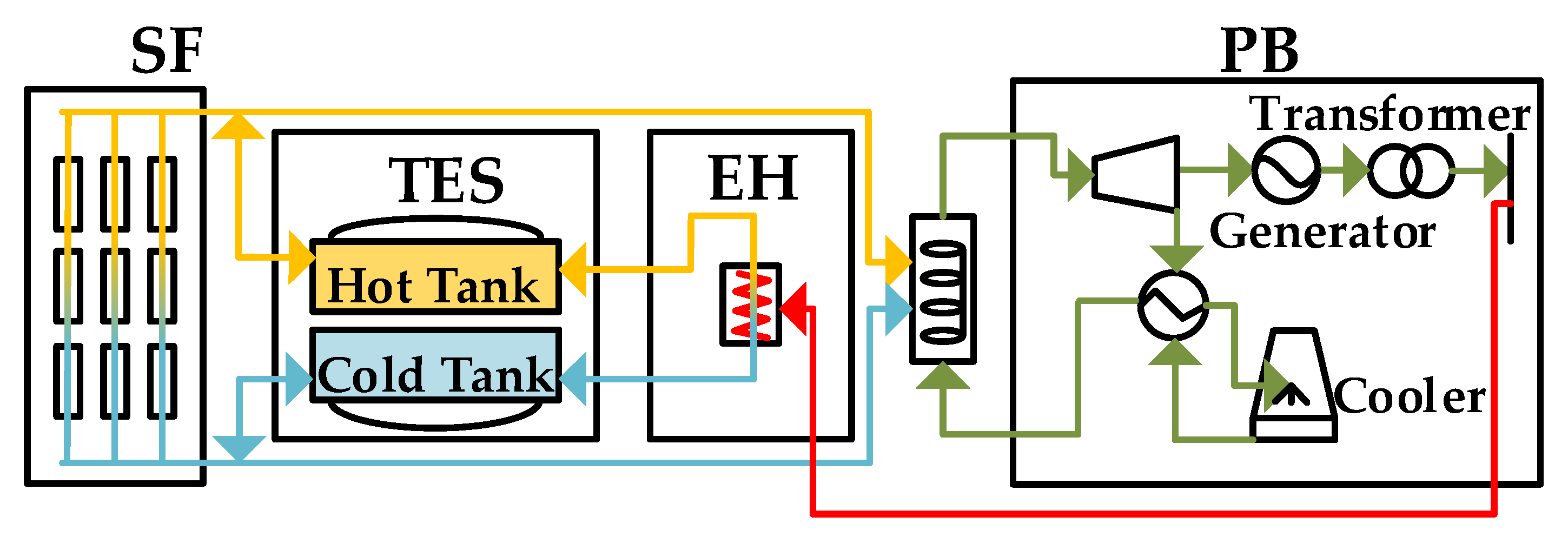
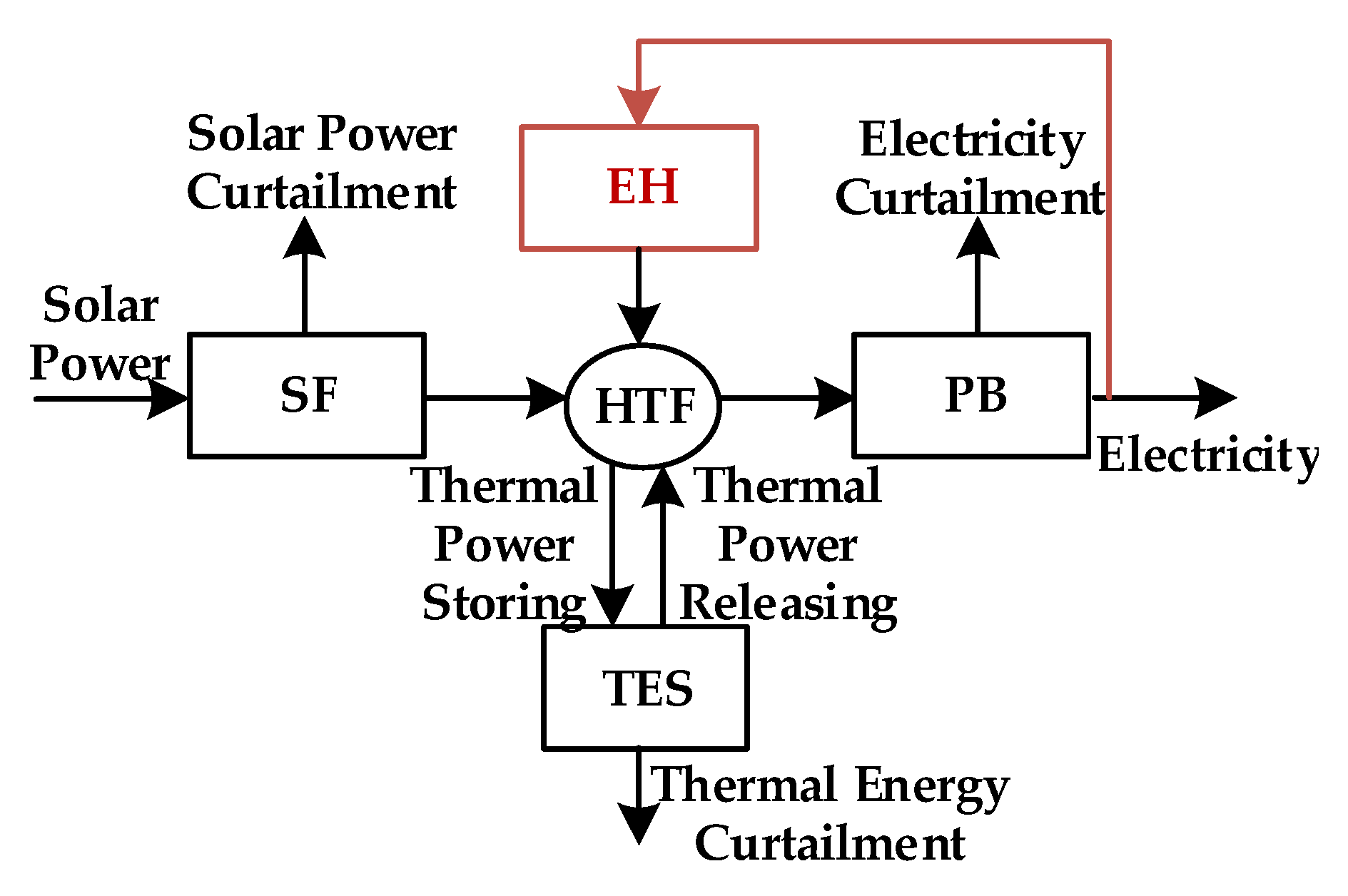
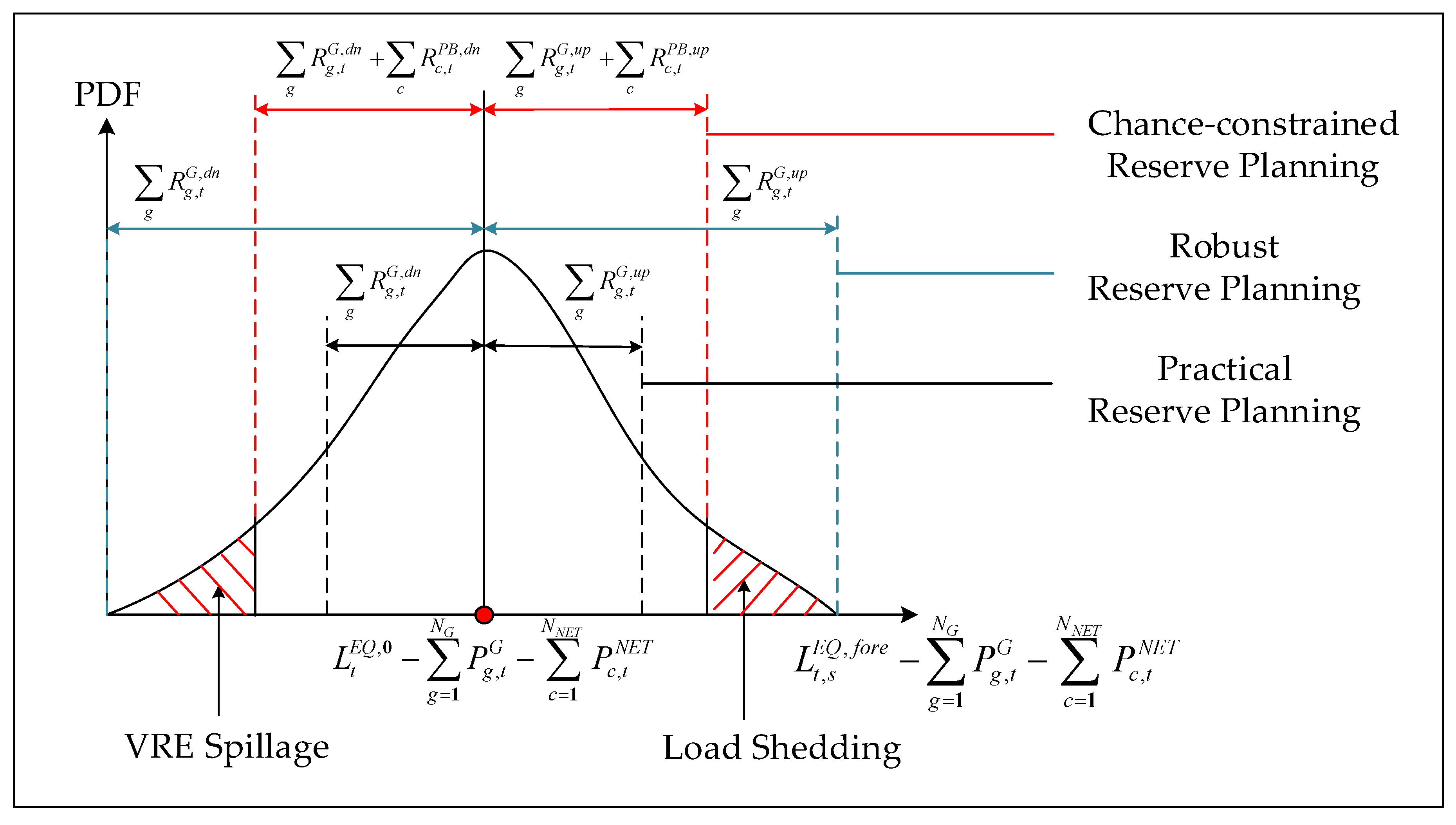

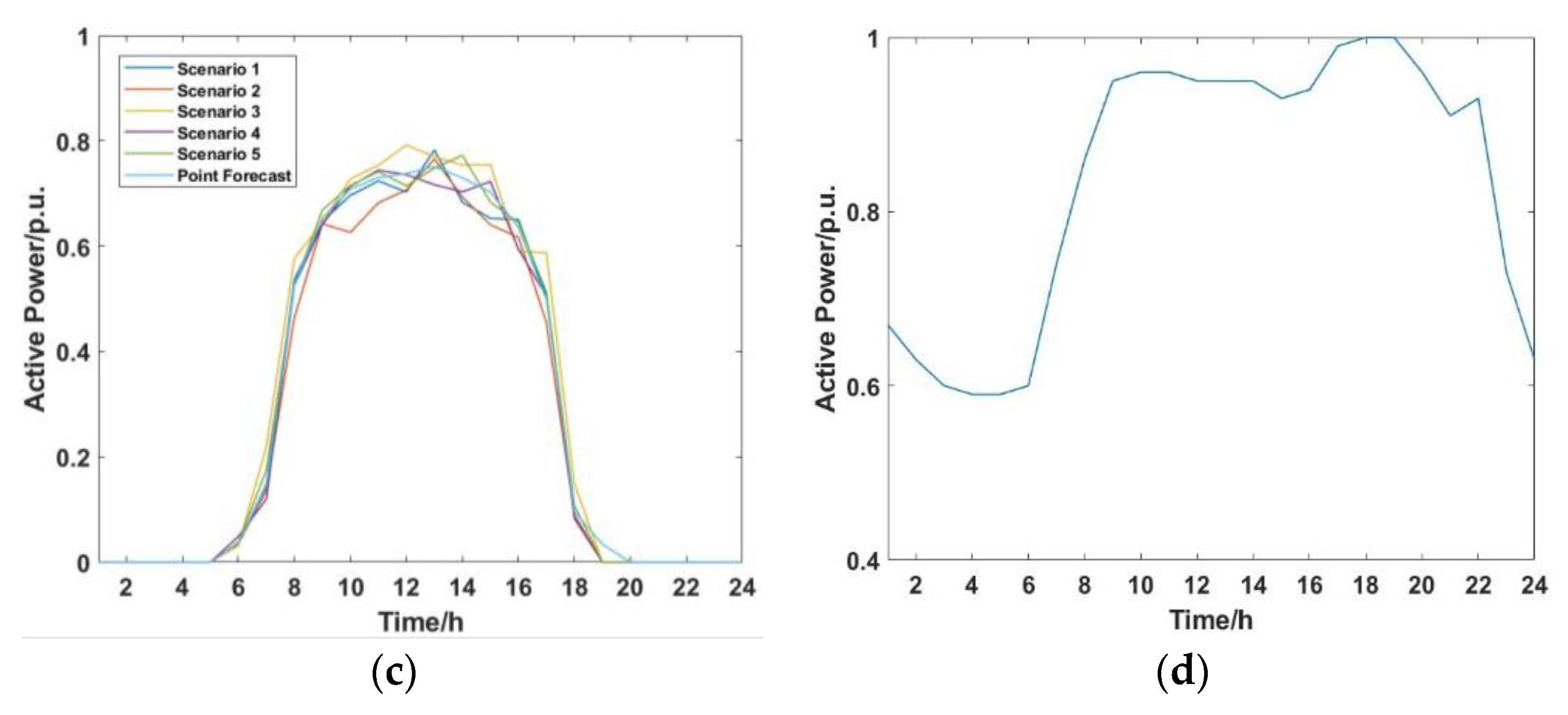

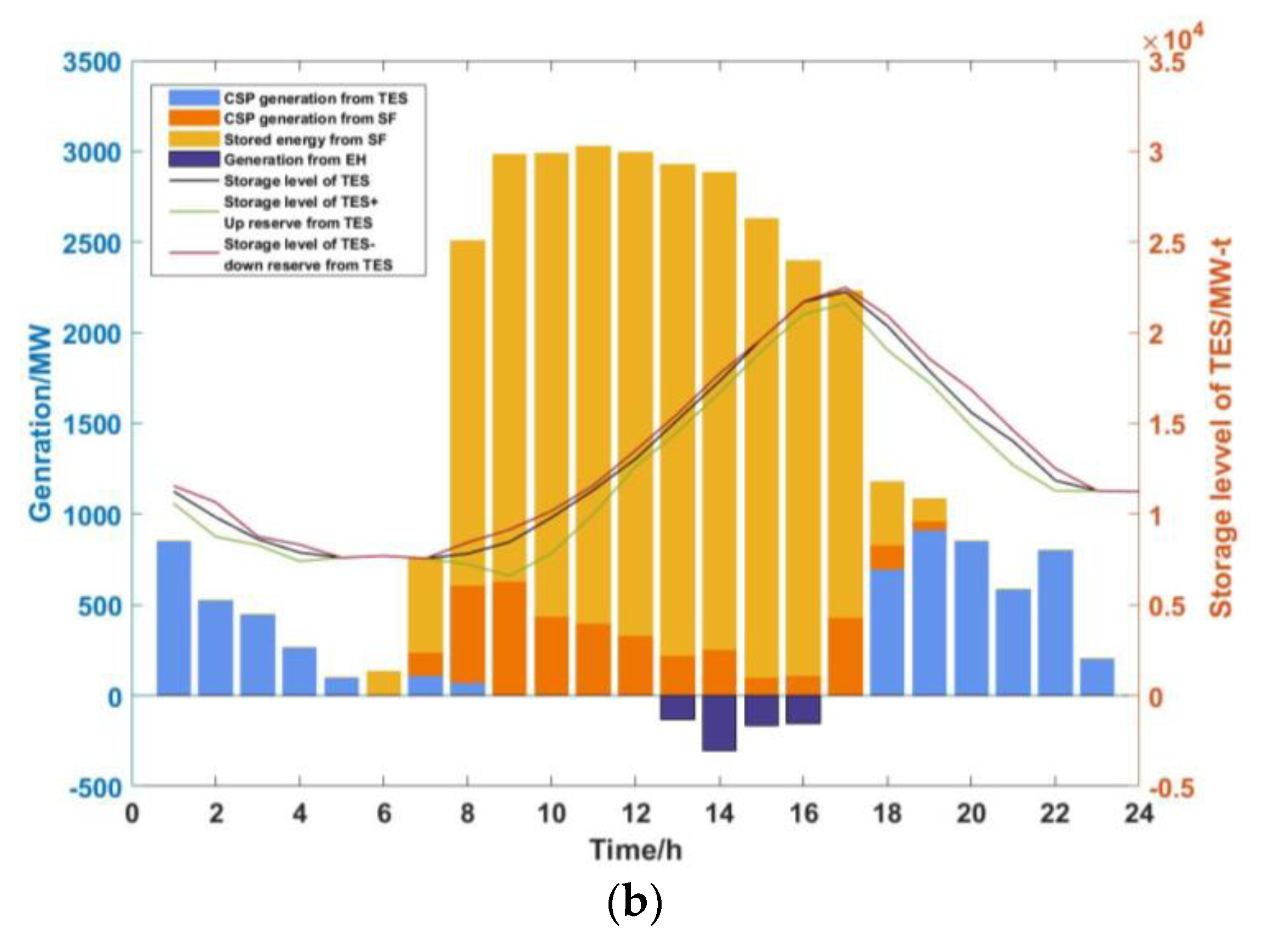
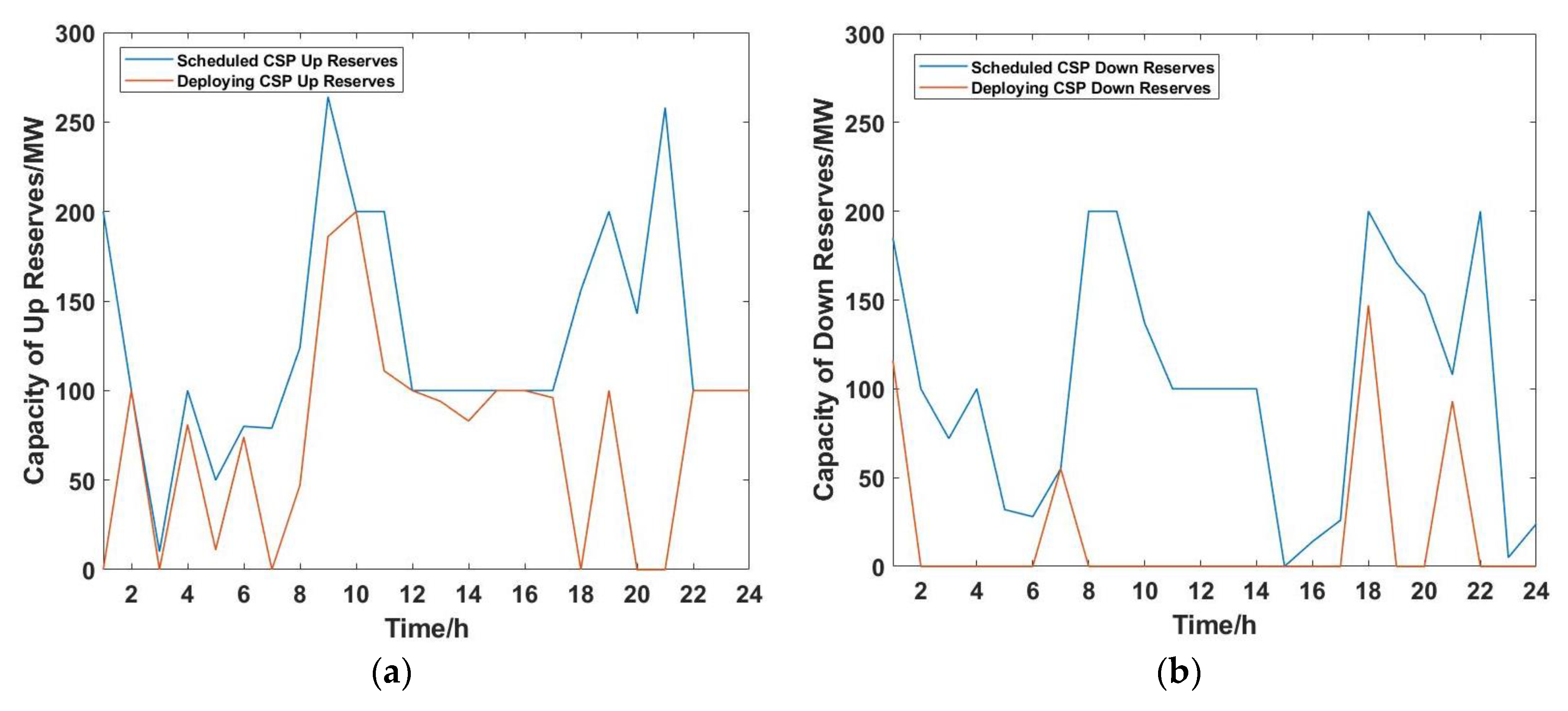
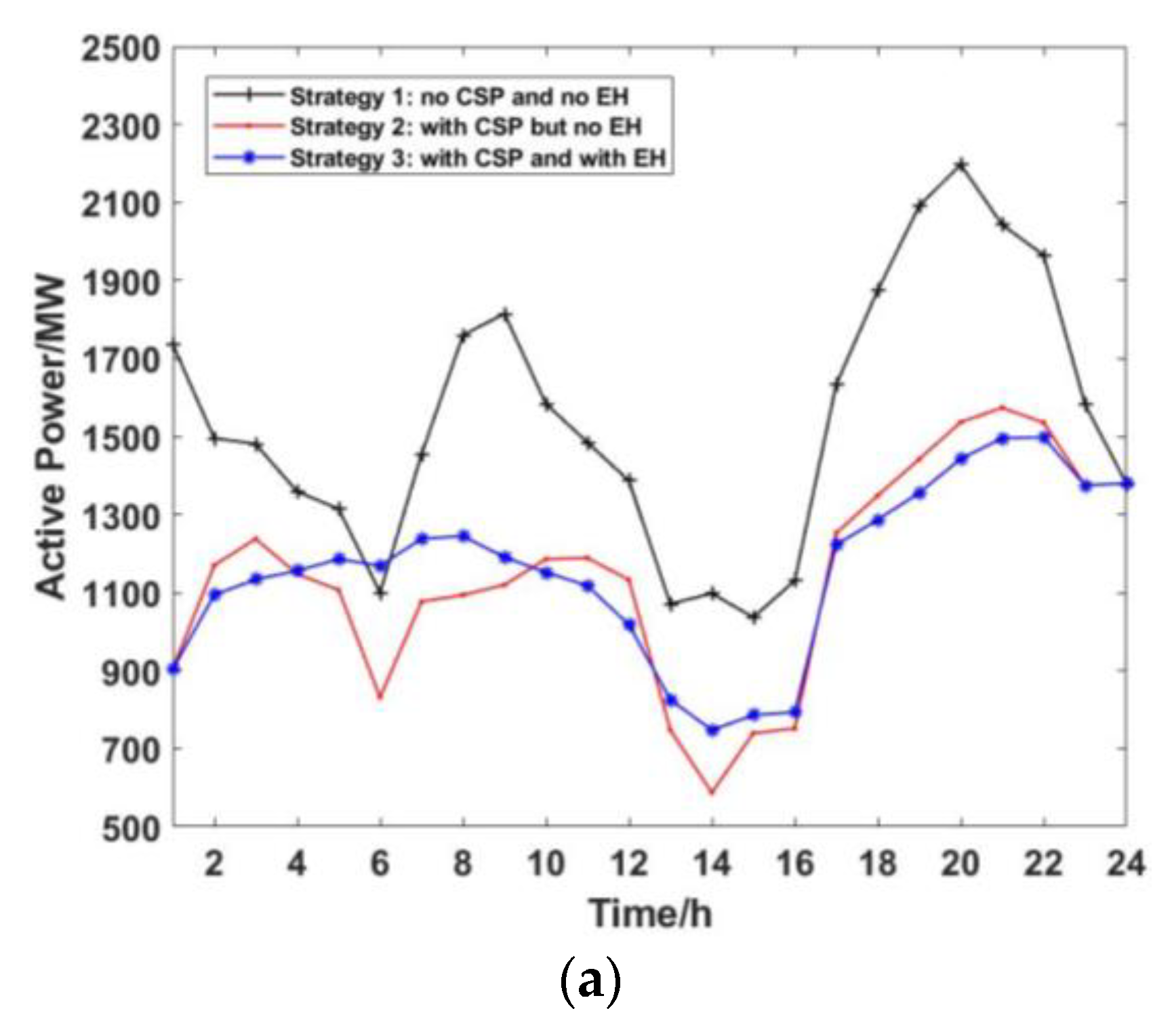


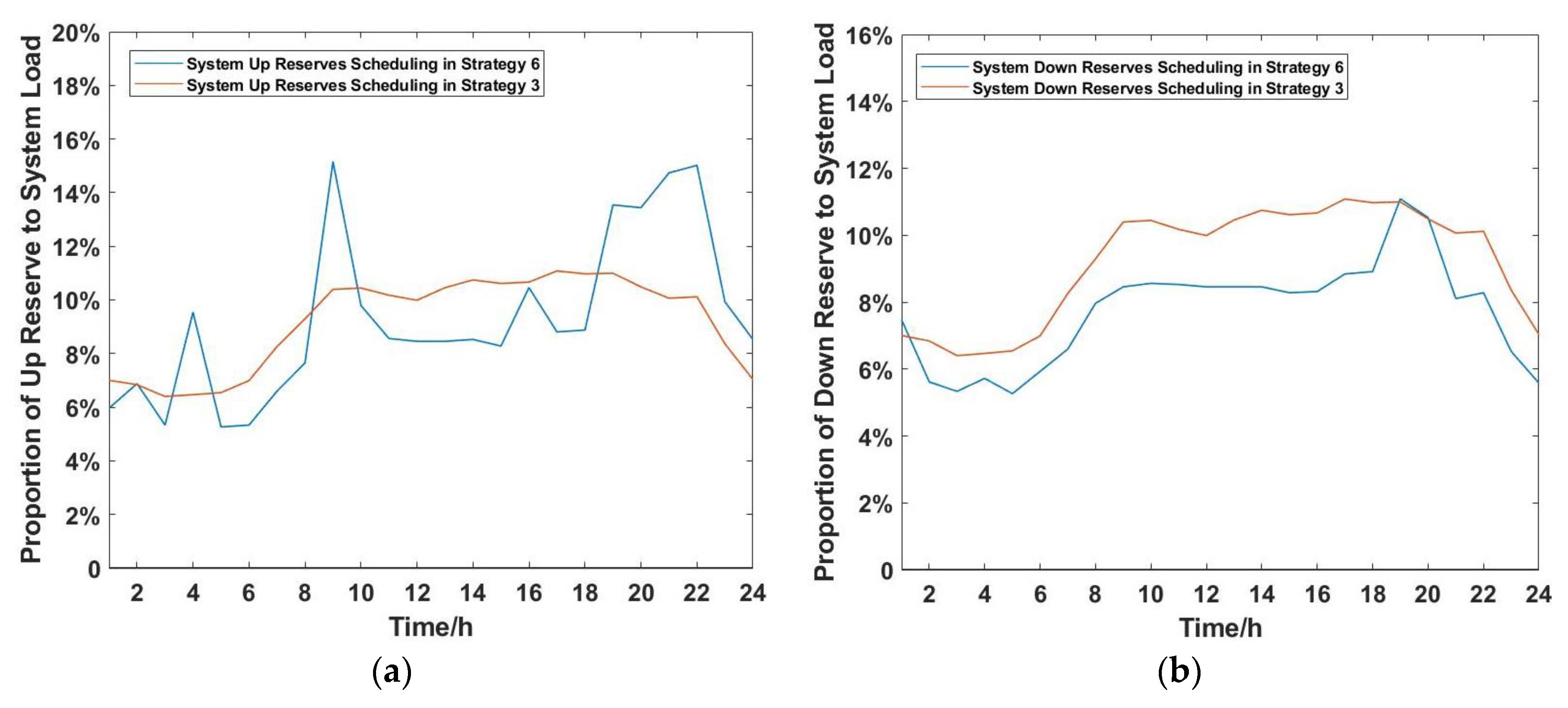
| Load | Thermal Unit | CSP | PV | Wind Power | |
|---|---|---|---|---|---|
| Quality/N | 17 | 15 | 3 | 3 | 3 |
| Total Capacity/MW | 2850 | 2412 | 1500 | 1500 | 900 |
| Parameter | Value | Parameter | Value |
|---|---|---|---|
| △, △ | 50% | Initial State of Charge (SOC) | 50% |
| , | 2(h) | 50 MW−t | |
| Solar Multiple (SM) | 2.4 | 38% | |
| Full-load Hour (FLH) | 15(h) | , | 98% |
| 0.003 | , | 30% |
| Time/h | Thermal Unit Number | |||||||
|---|---|---|---|---|---|---|---|---|
| 4 | 9 | 10 | 11 | 12 | 13 | 14 | 15 | |
| 1 | 1 | 1 | 1 | 1 | 1 | 1 | 1 | 1 |
| 2 | 1 | 1 | 1 | 1 | 1 | 1 | 1 | 1 |
| 3 | 1 | 1 | 1 | 1 | 1 | 1 | 1 | 1 |
| 4 | 1 | 1 | 1 | 1 | 1 | 1 | 1 | 1 |
| 5 | 1 | 1 | 1 | 1 | 1 | 1 | 1 | 1 |
| 6 | 1 | 1 | 1 | 1 | 1 | 1 | 1 | 1 |
| 7 | 1 | 1 | 1 | 1 | 1 | 1 | 1 | 1 |
| 8 | 1 | 1 | 1 | 1 | 1 | 1 | 1 | 1 |
| 9 | 1 | 1 | 1 | 1 | 1 | 1 | 1 | 1 |
| 10 | 1 | 1 | 1 | 1 | 1 | 1 | 1 | 1 |
| 11 | 1 | 1 | 1 | 1 | 1 | 1 | 1 | 1 |
| 12 | 1 | 1 | 1 | 1 | 1 | 1 | 1 | 1 |
| 13 | 1 | 1 | 0 | 1 | 0 | 0 | 1 | 1 |
| 14 | 1 | 1 | 0 | 1 | 0 | 0 | 1 | 1 |
| 15 | 0 | 1 | 0 | 1 | 0 | 0 | 1 | 1 |
| 16 | 1 | 1 | 0 | 1 | 0 | 0 | 1 | 1 |
| 17 | 1 | 1 | 1 | 1 | 1 | 1 | 1 | 1 |
| 18 | 1 | 1 | 1 | 1 | 1 | 1 | 1 | 1 |
| 19 | 1 | 1 | 1 | 1 | 1 | 1 | 1 | 1 |
| 20 | 1 | 1 | 1 | 1 | 1 | 1 | 1 | 1 |
| 21 | 1 | 1 | 1 | 1 | 1 | 1 | 1 | 1 |
| 22 | 1 | 1 | 1 | 1 | 1 | 1 | 1 | 1 |
| 23 | 1 | 1 | 1 | 1 | 1 | 1 | 1 | 1 |
| 24 | 1 | 1 | 1 | 1 | 1 | 1 | 1 | 1 |
| System Operating Costs ($) | Value |
|---|---|
| Fuel cost | 558,906.38 |
| Start-up cost | 2300 |
| Generating cost for CSP and EH | 50,701.16 |
| Penalty cost for load shedding | 0.00 |
| Penalty cost for renewables spillage | 1432.59 |
| Cost for thermal unit reserve scheduling | 13,756.84 |
| Cost for thermal unit reserve deploying | 1717.01 |
| Total system cost | 644,287.84 |
| Strategy | Description |
|---|---|
| Strategy 1 | Reserve adopts 10% of load forecast + additional 5% of wind forecast No CSP reserve, and no EH |
| Strategy 2 | Reserve adopts 10% of load forecast + additional 5% of wind forecast With CSP reserve, but no EH |
| Strategy 3 | Reserve adopts 10% of load forecast + additional 5% of wind forecast With CSP reserve, and with EH |
| Strategy 4 | Reserve adopts chance-constrained programming No CSP reserve, and no EH |
| Strategy 5 | Reserve adopts chance-constrained programming With CSP reserve, but no EH |
| Strategy 6 | Reserve adopts chance-constrained programming With CSP reserve, and with EH |
| Strategy | Fuel Costs and Start-Up Costs ($) | Penalty Costs for Load Shedding ($) | Penalty Costs for Renewables Spillage ($) |
|---|---|---|---|
| Strategy 1 | 607,959.73 | 2005.3 | 5129.12 |
| Strategy 2 | 609,017.21 | 1705.31 | 2153.51 |
| Strategy 3 | 610,477.49 | 179.29 | 1274.90 |
| Strategy 4 | 610,624.39 | 197.55 | 6006.07 |
| Strategy 5 | 611,379.23 | 161.18 | 2715.00 |
| Strategy 6 | 611,907.54 | 0.00 | 1432.59 |
| Strategy | Costs for Reserve Scheduling ($) | Costs for Reserve Deploying ($) | System Costs ($) |
| Strategy 1 | 39,615.54 | 6572.71 | 704,195.06 |
| Strategy 2 | 16,363.14 | 5575.36 | 660,028.64 |
| Strategy 3 | 14,402.79 | 2177.49 | 645,092.24 |
| Strategy 4 | 24,599.49 | 5846.88 | 674,393.30 |
| Strategy 5 | 15,963.14 | 4721.84 | 658,952.82 |
| Strategy 6 | 13,756.84 | 1717.01 | 644,287.84 |
© 2019 by the authors. Licensee MDPI, Basel, Switzerland. This article is an open access article distributed under the terms and conditions of the Creative Commons Attribution (CC BY) license (http://creativecommons.org/licenses/by/4.0/).
Share and Cite
Gao, S.; Zhang, Y.; Liu, Y. Incorporating Concentrating Solar Power into High Renewables Penetrated Power System: A Chance-Constrained Stochastic Unit Commitment Analysis. Appl. Sci. 2019, 9, 2340. https://doi.org/10.3390/app9112340
Gao S, Zhang Y, Liu Y. Incorporating Concentrating Solar Power into High Renewables Penetrated Power System: A Chance-Constrained Stochastic Unit Commitment Analysis. Applied Sciences. 2019; 9(11):2340. https://doi.org/10.3390/app9112340
Chicago/Turabian StyleGao, Shan, Yiqing Zhang, and Yu Liu. 2019. "Incorporating Concentrating Solar Power into High Renewables Penetrated Power System: A Chance-Constrained Stochastic Unit Commitment Analysis" Applied Sciences 9, no. 11: 2340. https://doi.org/10.3390/app9112340
APA StyleGao, S., Zhang, Y., & Liu, Y. (2019). Incorporating Concentrating Solar Power into High Renewables Penetrated Power System: A Chance-Constrained Stochastic Unit Commitment Analysis. Applied Sciences, 9(11), 2340. https://doi.org/10.3390/app9112340





